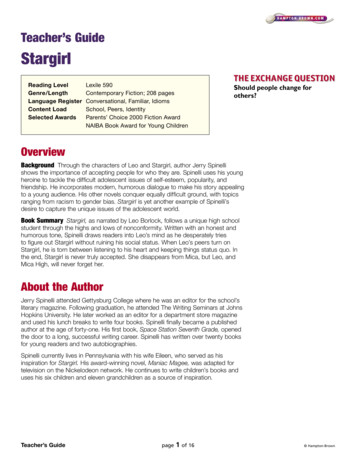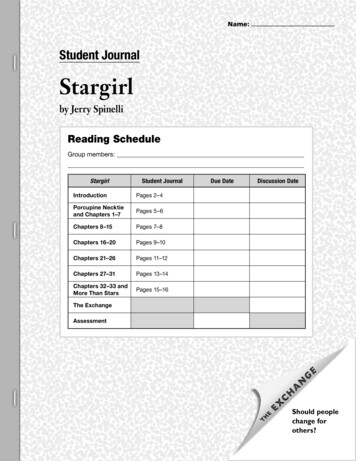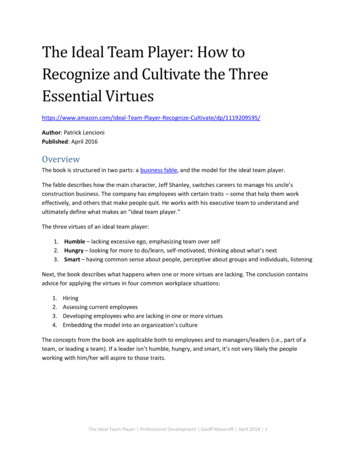
Transcription
VT CS 6604: Digital LibrariesIDEAL PagesProject GroupProject ClientAhmed ElberyMohammed FarghallyMohammed MagdyUnder Supervision OfProf. Edward A. Fox.Computer Science department, Virginia TechBlacksburg, VA5/8/20141IDEAL Pages
Table of Contents1.Abstract .42.Developer's Manual.52.1.Document Indexing .52.1.1.2.1.1.1.Solr Features .62.1.1.2.SolrCloud.62.1.1.3.schema.xml .72.1.1.4.Customizing the Schema for the IDEAL Pages .82.1.1.5.Solrctl Tool .82.1.1.6.Typical SolrCloud Configurations .92.1.2.2.2.Introduction to Solr .5Hadoop . 112.1.2.1.Hadoop File System (HDFS) . 112.1.2.2.MapReduce. 142.1.2.3.Event Indexer . 152.1.2.4.IndexDriver.java . 162.1.2.5.IndexMapper.java . 172.1.2.6.Event IndexerUsage Tutorial . 17Web Interface for the indexed documents . 212.2.1.Solr REST API . 212.2.2.Solarium . 222.2.2.1.Installing Solarium . 242.2.2.2.Using Solarium in your PHP code . 252.2.3.Other tools for the web interface. 262.2.4.Web Interface Architecture . 273.User's Manual . 284.Results and contributions . 315.Future works. 326.References . 327.Appendix . 332IDEAL Pages
List of FiguresFigure 1 Big Picture .4Figure 2 Solr Server vs. SolrCloud .7Figure 3 SolrCloudCollections and Shards . 11Figure 4 HDFS architecture . 13Figure 5 MapReduce Operation . 15Figure 6 The Events directory structure . 16Figure 7 Map-Reduce terminal Output . 20Figure 8 Solr Web interface . 21Figure 9 A Solr query result formatted in JSON. 22Figure 10 Web Interface Architecture . 27Figure 11 Web Interface Main Screen . 29Figure 12 Viewing Documents related to a particular event . 30Figure 13 Document Details . 30Figure 14 Search results and Pagination . 313IDEAL Pages
1. AbstractEvents create our most impressive memories. We remember birthdays, graduations, holidays,weddings, and other events that mark important stages of our life, as well as the lives of family andfriends. As a society were member assassinations, natural disasters, political uprisings, terrorist attacks,and wars as well as elections, heroic acts, sporting events, and other events that shape community,national, and international opinions. Web and Twitter content describes many of these societal events.Permanent storage and access to big data collections of event related digital information, includingwebpages, tweets, images, videos, and sounds, could lead to an important national asset. Regarding thatasset, there is need for digital libraries (DLs) providing immediate and effective access and archiveswith historical collections that aid science and education, as well as studies related to economic,military, or political advantage. So, to address this important issue, we will research an IntegratedDigital Event Archive and Library (IDEAL). [10]Our objective here in this project is to take the roughly 10TB of webpages collected for a variety ofevents, and use the available cluster to ingest, filter, analyze, and provide convenient access. In order toachieve this, automation of Web Archives (.warc files) extraction will be run on the cluster usingHadoop to distribute and speed up the process. HTML files will be parsed and indexed into Solr to bemade available through the web interface for convenient access.Figure 1 Big PictureFigure 1 show the big picture of the project architecture, the .warc files should be input to theextraction module on Hadoop cluster which is responsible of extracting the HTML files and extract thefile body into .txt files. Then the .txt files should be indexed using indexing module which runs also on4IDEAL Pages
Hadoop, the indexing module will directly update SolrCloud index which is also distributed on a clusterof machines. Using Hadoop cluster and SolrCloud for storing, processing and searching provide therequired level of efficiency, fault tolerance and scalability will be shown in upcoming sections. Finallythe users can access the indexed documents using a convenient web interface that communicates withSorlCloud service.This technical report is organized as follows: First we present a developer's manual describing thetools used in developing the project and how it was configured to meet our needs. Also a briefbackground about each tool is presented. Next we present a user manual describing how the end user canuse our developed web interface to browse and search the indexed document. Next Finally we present anappendix describing for subsequent groups that will continue and contribute to this project in the future,how they can install the application on their servers and how they can make it work in their owninfrastructure.2. Developer's Manual2.1. Document IndexingIn this section, the first phase of our project will be described which is "Document Indexing".Most of our discussion will be focused on the tools applied in this phase (Apache Solr and Hadoopmainly) and the step by step configuration of these tools to work as required for this project. First wewill present Solr, a search engine based on Lucene java search library used to index and store ourdocuments, and then we will present Hadoop which is required for fast distributed processing which isapplied for the indexing process into Solr since we have a tremendous amount of documents to beindexed.2.1.1. Introduction to SolrSolr is an open source enterprise search server based on the Lucene Java search library. Its majorfeatures include powerful full-text search, hit highlighting, faceted search, near real-time indexing,dynamic clustering, database integration, rich document (e.g., Word, PDF) handling, and geospatialsearch. Solr is highly reliable, scalable and fault tolerant, providing distributed indexing, replication andload-balanced querying, automated failover and recovery, centralized configuration and more. Solrpowers the search and navigation features of many of the world's largest internet sites. Solr is written inJava and runs as a standalone full-text search server within a servlet container such as Jetty. Solr uses5IDEAL Pages
the Lucene Java search library at its core for full-text indexing and search, and has REST-likeHTTP/XML and JSON APIs that make it easy to use from virtually any programming language [1].2.1.1.1.Solr FeaturesSolr is a standalone enterprise search server with a REST-like API. You can post documents to it(called "indexing") via XML, JSON, CSV or binary over HTTP. You can query it via HTTP GET andreceive XML, JSON, CSV or binary results. Advanced Full-Text Search Capabilities Optimized for High Volume Web Traffic Standards Based Open Interfaces - XML, JSON and HTTP Comprehensive HTML Administration Interfaces Server statistics exposed over JMX for monitoring Linearly scalable, auto index replication, auto failover and recovery Near Real-time indexing Flexible and Adaptable with XML configuration Extensible Plugin Architecture2.1.1.2.SolrCloudSolrCloud is a set of Solr instances running on a cluster of nodes with capabilities and functions thatenable these instances to interact and communicate so as to provide fault tolerant scaling [2]. SolrCloud supports the following features: Central configuration for the entire cluster Automatic load balancing and fail-over for queries ZooKeeper integration for cluster coordination and configuration.SolrCloud uses ZooKeeper to manage nodes, shards and replicas, depending on configuration filesand schemas. Documents can be sent to any server and ZooKeeper will figure it out. SolrCloud is basedon the concept of shard and replicate, Shard to provide scalable storage and processing, and Replicatefor fault tolerance and throughput.6IDEAL Pages
Figure 2 Solr Server vs. SolrCloudFigure 2 briefly shows scalability, fault tolerance and throughput in SolrCloud compared to singleSolr server.We use Cloudera in which a SolrCloud collection is the top level object for indexing documents andproviding a query interface. Each SolrCloud collection must be associated with an instance directory,though note that different collections can use the same instance directory. Each SolrCloud collection istypically replicated among several SolrCloud instances. Each replica is called a SolrCloud core and isassigned to an individual SolrCloud node. The assignment process is managed automatically, thoughusers can apply fine-grained control over each individual core using the core command.2.1.1.3.schema.xmlThe schema.xml is one of the configuration files of Solr that is used to declare [5]: what kinds and types of fields there are. which field should be used as the unique/primary key. which fields are required. how to index and search each field.The default schema file comes with a number of pre-defined field types. It is also a self-documentaryso you can find documentation for each part in the file. You can also use them as templates for creatingnew field types.7IDEAL Pages
2.1.1.4.Customizing the Schema for the IDEAL PagesFor our project we need to customize the schema file to add the required fields that we need to usefor indexing the events’ files. The fields we used are:id : indexed document ID, this ID should be unique for each document.category: the event category or type such as (earthquake, Bombing etc.)name: event nametitle: the file namecontent: the file contentURL: the file path on the HDFS systemversion: automatically generated by Solr.text: a copy of the name, title, content and URL fields.We need to make sure that these fields are in the schema.xml file, if any of them is not found wehave to add it to the schema file. Also we need to change the “indexed” and “stored” properties of boththe “content” and the “text” fields to be “true”.2.1.1.5.Solrctl ToolWe use Cloudera Hadoop, in which solrctl tool is used to manage a SolrCloud deployment,completing tasks such as manipulating SolrCloud collections, SolrCloud collection instance directories,and individual cores[3].A typical deployment workflow with solrctl consists of deploying ZooKeeper coordination service,deploying Solr server daemons to each node, initializing the state of the ZooKeeper coordination serviceusing solrctl init command, starting each Solr server daemon, generating an instance directory,uploading it to ZooKeeper, and associating a new collection with the name of the instance directory.In general, if an operation succeeds, solrctl exits silently with a success exit code. If an erroroccurs, solrctl prints a diagnostics message combined with a failure exit code [3].The solrctl command details are on solrctl Reference on Cloudera documentation website. And youcan use solrctl --help command to show the commands and options[4].The following is a list of detailedtutorials about installing, configuring and running SolrCloud, these tutorials are found on Clouderawebsite:Deploying Cloudera Search in SolrCloud ModeInstalling Solr PackagesInitializing Solr for SolrCloud Mode8IDEAL Pages
Configuring Solr for Use with HDFSCreating the /solr Directory in HDFSInitializing ZooKeeper NamespaceStarting Solr in SolrCloud ModeAdministering Solr with the solrctl ToolRuntime Solr ConfigurationCreating Your First Solr CollectionAdding Another Collection with Replication2.1.1.6.Typical SolrCloud ConfigurationsWe use the solrctl tool to configure SolrCloud, create the configuration files and create collections.Also we can use it for other purpose such as deleting the index for a particular collection. Following arethe steps we use to configure and run the SolrCloud.a- Initializing SolrCloudIf the SolrCloud is not initialized then we need to start the Cloudera Search server. So first you needto create the /solr directory in HDFS. The Cloudera Search master runs as solr:solr so it does not havethe required permissions to create a top-level directory. To create the directory we can use the Hadoop fsshield as shown in the next commands sudo -u hdfshadoop fs -mkdir /solr sudo -u hdfshadoop fs -chownsolr /solrThen we need to create a Zookeeper Namespace using the command solrctlinitNow SolrCloud should be running properly but without any data collection created.9IDEAL Pages
b- Creating a ConfigurationIn order to start using Solr for indexing the data, we must configure a collection holding the index. Aconfiguration for a collection requires a solrconfig.xml file, schema.xml and any helper files may bereferenced from the xml files. The solrconfig.xml file contains all of the Solr settings for a givencollection, and theschema.xml file specifies the schema that Solr uses when indexing documents.To generate a skeleton of the instance directory run: solrctlinstancedir --generate HOME/solr configsAfter creating the configuration, we need to customize the schema.xml as mentioned in schema.xmlsection.c- Creating a CollectionAfter customizing the configuration we need to make it available for Solr to use by issuing thefollowing command, which uploads the content of the entire instance directory to ZooKeeper: solrctlinstanced --create collection1 HOME/solr configsNow we can create the collection by issuing the following command in which we specify the collectionname and the number of shards for this collection solrctl collection --create collection1 -s {{numOfShards}}d- Verifying the CollectionOnce you create a collection you can use Solr web interface through http://host:port/solr (the hostis the URL or the IP address of the Solr server, the port is the Solr service port by default it is 8983). Bygoing to the Cloud menu, it will show the collections created and the shards for each one. as shown inFigure 3, there are two collections collection1 and collection3. Collection 3 has two shards and all ofthem are on the same server instance.10IDEAL Pages
Figure 3 SolrCloudCollections and Shards2.1.2. HadoopIn this section we will give a brief overview on Hadoop and its main components, HadoopDistributed File System (HDFS) and, Map-Reduce.Hadoop is an open-source software framework for storage and large-scale processing of data-sets onclusters of commodity hardware. Hadoop is characterized by the following features: Scalable: It can reliably store and process PetaBytes. Economical: It distributes the data and processing across clusters of commonly availablecomputers (in thousands). Efficient: By distributing the data, it can process it in parallel on the nodes where the data islocated. Reliable: It automatically maintains multiple copies of data and automatically redeployscomputing tasks based on failures.2.1.2.1.Hadoop File System (HDFS)The Hadoop Distributed File System (HDFS) is a distributed file system designed to run oncommodity hardware. HDFS is highly fault-tolerant and is designed to be deployed on low-costhardware. HDFS provides high throughput access to application data and is suitable for applications thathave large data sets [6].11IDEAL Pages
Files are stored on HDFS in form of blocks, the block size 16MB to 128MB. All the blocks of thesame file should be of the same size except the last one. The blocks are stored and replicated on differentnodes called Data nodes. For better high availability the replicas should be stored on other rack, so thatif any rack is becomes down (i.e. for maintenance) the blocks are still accessible on the other racks.As shown in Figure 4 HDFS has master/slave architecture. An HDFS cluster consists of a singleName node, a master server that manages the file system namespace and regulates access to files byclients. In addition, there are a number of Data nodes, usually one per node in the cluster, which managestorage attached to the nodes that they run on. HDFS exposes a file system namespace and allows userdata to be stored in files. Internally, a file is split into one or more blocks and these blocks are stored in aset of Data nodes. The Name node executes file system namespace operations like opening, closing, andrenaming files and directories. It also determines the mapping of blocks to Data nodes. The Data nodesare responsible for serving read and write requests from the file system’s clients. The Data nodes alsoperform block creation, deletion, and replication upon instruction from the Name node. For more detailsabout HDFS refer to [6].Another important tool that we use in the project is the Hadoop file system (fs) shell commands areused to perform various file operations like copying file, changing permissions, viewing the contents ofthe file, changing ownership of files, creating directories etc. If you need more details about HadoopFS shell you can refer to [7].12IDEAL Pages
Figure 4 HDFS architectureBut here we will discuss the some commands that we will use or need in our project. For example tocreate a directory on HDFS and change its user permissions we use the following two commands hadoop fs -mkdir /user/cloudera hadoop fs -chowncloudera /user/clouderaTo remove a directory we can use hadoop fs -rmdiror hadoop fs -rmrdirThe -rm command removes the directory while the -rmr is a recursive version to delete none emptydirectories.To move a directory we can use hadoop fs -mv source1 [source1 ] dest Moves files from source to destination. This command allows multiple sources as well in which casethe destination needs to be a directory.13IDEAL Pages
An important command that we need is the -put command that uploads data from the local filesystem to HDFS. hadoop fs -put localsrc . dst This command can copy single source , or multiple sourcesfrom local file system to the destinationHDFS as shown in the following commands. hadoop fs -put localfile /user/hadoop/hadoopfile hadoop fs -put localfile1 localfile2 /user/hadoop/hadoopdir hadoop fs -put localfile ReduceHadoop Map-Reduce is a software framework for writing applications which process vast amountsof data (multi-terabyte data-sets) in-parallel on large clusters (thousands of nodes) of commodityhardware in a reliable, fault-tolerant manner[8].MapReduce uses the following terminologies to differentiate between kinds of process it runs. Job – A “full program” - an execution of a Mapper and Reducer across a data set Task – An execution of a Mapper or a Reducer on a slice of data Task Attempt – A particular instance of an attempt to execute a task on a machineAtypical Map-Reduce program consists of Map and Reduce tasks in addition to a Master task thatdrives the whole program. The Master task can also overwrite the default configuration of theMapReduce such as the data flow between the Mappers and Reducer.A Map-Reduce job usually splits the input data-set into independent chunks called inputsplitseachinput-split is a set of conjunct blocks. These splits are processed by the map tasks in acompletely parallel manner. The framework sorts the outputs of the maps, which are then input tothe reduce tasks as shown in Figure 5. The framework takes care of scheduling tasks, monitoring themand re-executes the failed tasks.14IDEAL Pages
Figure 5 MapReduce OperationTypically the compute nodes and the storage nodes are the same, that is, the MapReduce frameworkand the Hadoop Distributed File System are running on the same set of nodes. This configuration allowsthe framework to effectively schedule tasks on the nodes where data is already present, resulting in veryhigh aggregate bandwidth across the cluster.The Map-Reduce framework has a single master JobTracker and one slave TaskTracker per clusternode. The master is responsible for scheduling the jobs' component tasks on the slaves, monitoring themand re-executing the failed tasks. The slaves execute the tasks as directed by the master [8].2.1.2.3.Event IndexerIn this section we will describe the Event Indexer tool that we developed and then give a tutorial onhow to use it.The input data is a set of text files extracted from the WARC files. And we need to index these filesinto SolrCloud to make them accessible. The Event Indexer will read those files from the HDFS asinput to the Mapper. The Mapper will read each file and create the fields and update SolrCloud by thisnew document. It is clear that we do not need a Reducer because the Mapper directly sends its output tothe SolrCloud which in its turn add the files to the index using the fields received from theEvent Indexer. The overall indexing process is performed in parallel distributed manner, that is, bothEvent Indexer and SolrCloud run in distributed manner on the cluster on machines.15IDEAL Pages
The Event Indexer has two main classes; the IndexDriver and the IndexMapper. We built them inJAVA using Eclipse on CentOS machine.2.1.2.4.IndexDriver.javaThis is the master module of the program, which receives the input arguments from the system thencreates and configures the job and then submit this job to be scheduled on the system. The syntax of theEvent Indexer command is: hadoop jar Event Indexer.jar-input input dir/**/* -output outdir-solrserver SolrServer–collection collection nameThe program receives two required parameters in the command line which are the input and outputdirectories. The input directory contains the files to be indexed. The files should be arranged inhierarchical structure of “input dir/category dir/event dir/files”. The input dircontains a set of subdirectories; each one is for a category of the events and should be named as the category. Each categorydirectory contains a set of sub-directories also each one is for a particular event and also should benamed as the event name. Each of these event directories contains all the files related to this event. Thisstructure is shown in Figure 6. The importance of this structure is that the mapper uses it to figure outthe category and the event name of each file. So this structure works as a metadata for the event files.The output directory will be used as a temporary and log directory for the Event Indexer. It will nothas any indexing data because the index will be sent to the Solr server.Figure 6 The Events directory structure16IDEAL Pages
To give the program more flexibility we implemented the Event Indexer in such away it cancommunicate with SolrCloud on different cluster and update its index using the Solr API. So we whenrunning the program we can specify the Solr Server URL using the “-solrserver” option in the commandline. Also we can specify which collection to be updated using the “-collection” option as we will seelater. This feature enables the Event Indexerto run on a cluster and update Solron another cluster. If thecommand line has no “-solrserver” option the program will use the default Solrserverhttp://localhost:8983/solr. And if it does not have a “-collection” option the default collection iscollection1.SobydefaulttheEvent /solr/collection1.After parsing the arguments, the IndexDriver then initiate and configure a job to be run. The jobconfiguration includes: Assigning the Mapper using the to be the IndexMapper.class Setting the number of Reducer to Zero because we do not need Reducers. Setting the input directory Setting the output directory2.1.2.5.IndexMapper.javaThe IndexMapper reads all the lines from the file and sum-up them to form the content of the file. Italso finds out the event category, the event name, the file URL as well as the file name which are someof the fields of the document to be indexed. The category and the event name are extracted from the filepath as described previously. The file name and the URL are properties of the map job configuration.The mapper also calculates the document ID field. To calculate the find the ID we use the java builtin hashcodebased on the file URL. This means that if the same file transferred to another location andthen indexed then the Solr will add a new document to its index because of the different ID.After reading all the file line and before the mapper closes, it updates the Solr server with the newdocument through the Solr “add” API and then commits this document using the Solr “commit” API.SolrCloud Service receives these documents from the Mapper and adds them to its index which isalso distributed on the HDFS.2.1.2.6.Event Indexer Usage TutorialTo index data set using the Event Indexer you should follow these steps17IDEAL Pages
1. First you must make sure that the Solr Service is running properly. You can do that by browsingthe Solr Server URL on port 89832. If Solr Service is not running you can restart it from the Cloudera Service Manager3. If it is running but has no collections, you can add collections as shown in the SolrCloud sectionusing the solrctl tool4. If you wish to clear the index of the collection, you can use the command solrctl collection --deletedocscollection name5. Prepare the data to be indexed: the files should be organized in the hierarchical structuredescribed earlier. We assume the data a
We use Cloudera Hadoop, in which solrctl tool is used to manage a SolrCloud deployment, completing tasks such as manipulating SolrCloud collections, SolrCloud collection instance directories, and individual cores[3]. A typical deployment workflow with solrctl consists of deploying ZooKeeper coordination service,










